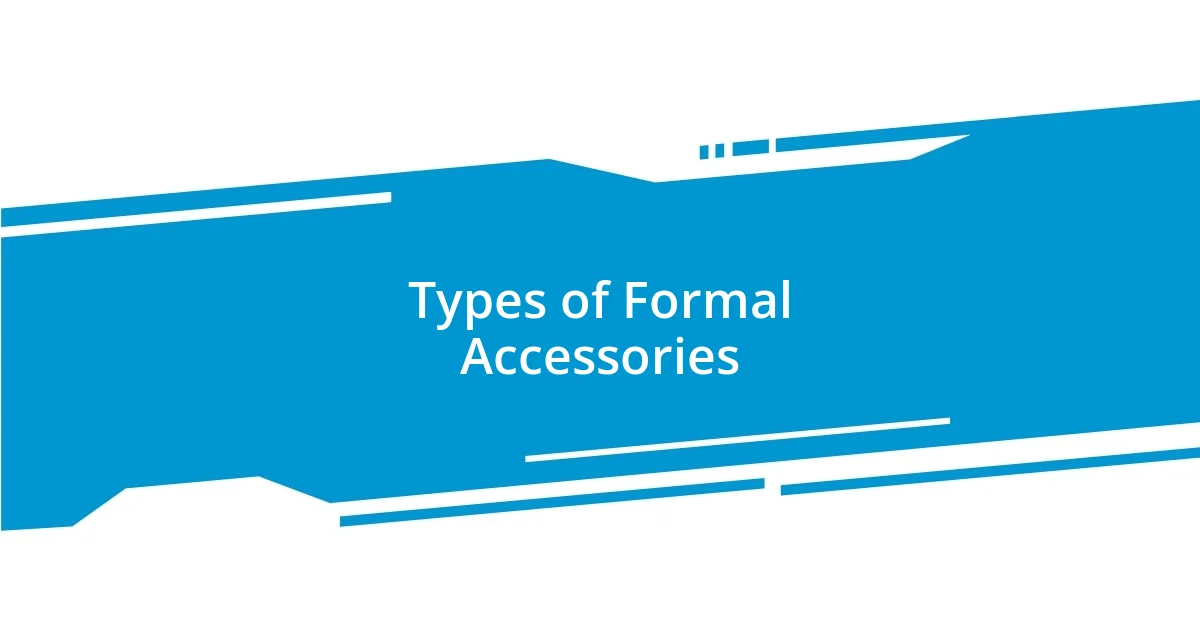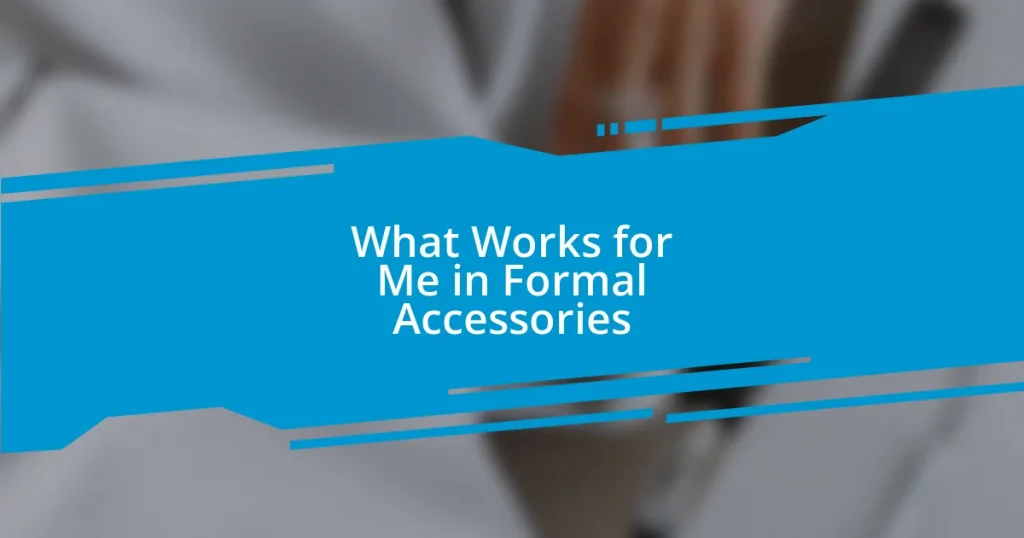Key takeaways:
- Choosing the right formal accessories enhances not only your outfit but also your confidence and how others perceive you.
- Color coordination and material selection play a crucial role in accessory choice, significantly impacting the overall look and feel of an ensemble.
- Personalizing accessories adds individuality and can create meaningful connections, making a lasting impression in both formal and casual settings.

Understanding Formal Accessories
Formally accessorizing is more than just adding a tie or cufflinks; it’s about conveying confidence and style. I remember my first big presentation at work, where I chose a silk tie that perfectly complemented my blazer. The moment I put it on, I felt a wave of assurance wash over me—proof that the right accessories can elevate not just an outfit, but your entire demeanor.
When we think about formal accessories, we should consider their functionality and how they can enhance our overall look. A well-chosen watch doesn’t just tell time; it can also express your personality. Have you ever noticed how a simple clasp on a bracelet can become a conversation starter? It’s fascinating how something small can carry significant weight in a formal setting.
Equally important is understanding the subtlety of color and texture in formal accessories. For instance, I once paired a matte black belt with a shiny pair of shoes, and the contrast made a striking impression at a gala. This experience taught me how details, often overlooked, can tie an ensemble together beautifully and ensure you’re remembered for all the right reasons.

Importance of Selecting Accessories
Selecting the right accessories is crucial in making a lasting impression. I recall attending a formal wedding where I meticulously chose a pocket square that matched my date’s dress. The compliments I received throughout the evening confirmed the power of thoughtful accessorizing—it’s amazing how such details can forge connections with others.
Moreover, the right accessories can serve to unify your look. I remember attending a business meeting where my tailored suit felt incomplete until I added a classic watch. The moment it was on my wrist, I felt a shift in perception; it brought a definitive polish that translated into confidence and professionalism. It’s not just about aesthetics; it’s about how these choices can impact how others perceive you.
Lastly, one must not overlook the balance of sophistication and personal flair when choosing accessories. I once experimented with mixing modern cufflinks with a vintage tie clip at an art opening. Surprisingly, the combination sparked intriguing conversations, bridging styles in a way that felt uniquely me. This taught me that accessories can be an expression of individuality, amplifying your style while respecting formal environments.
| Accessorizing Importance | Personal Experience |
|---|---|
| Creating Lasting Impressions | Wedding pocket square proven to make connections |
| Unifying Your Look | Classic watch added professionalism in a meeting |
| Expressing Individuality | Modern cufflinks with vintage tie clip sparked conversations |

Types of Formal Accessories
Formal accessories come in many styles, and each type serves a unique purpose in elevating your overall look. I’ve experienced how the right choice of accessories can completely change the vibe of an outfit. For instance, while attending a gala, I opted for a pair of classic leather gloves. Not only did they keep my hands warm, but they also added a touch of elegance that made me feel more put-together and sophisticated.
Here’s a list of different types of formal accessories that can help elevate your attire:
- Ties and Bowties: Whether it’s silk or cotton, these pieces can demonstrate your personality and add color to a suit.
- Cufflinks: Not just practical, they show meticulous attention to detail and can showcase your taste.
- Pocket Squares: A subtle accent that can harmonize or contrast with your outfit.
- Watches: A classic timepiece adds professionalism and often serves as a conversation starter.
- Belts: The right belt can tie together your outfit; think classic leather versus adventurous patterns.
- Bracelets: Sleek, understated bracelets can add a modern twist without overwhelming your look.
- Scarves: Particularly in colder months, they can enhance both warmth and style.
Once, I wore a bold pocket square, contrasting beautifully with my navy suit, and I felt an immediate boost in my confidence. It’s those small details that, I think, can transform not just your outfit but also your presence in any formal setting.

Choosing the Right Materials
When it comes to choosing the right materials for formal accessories, I always consider the experience and context. For example, I once wore a wool tie to a winter event, and it not only kept me warm but also added a richness to my look that I loved. The texture felt luxurious against my skin, and it made me wonder: how often do we overlook the impact that fabric choice can have on our confidence?
Silk is often my go-to fabric, especially for ties and pocket squares. At a summer wedding, I wore a silk pocket square that caught the light beautifully, and I could literally feel the shift in energy around me as people noticed the detail. There’s something about the way silk drapes that exudes sophistication—it elevates an outfit in a way that makes me feel both elegant and approachable. Have you ever experienced that moment when a small detail transforms your outfit entirely?
Then there’s leather, a material I deeply appreciate for accessories like belts and shoes. I vividly recall wearing a leather belt that I had chosen specifically for its supple texture; it not only complemented my suit but also felt like a comforting embrace. It’s incredible how the right material can contribute to the overall mood of an ensemble. I’ve always believed that accessories should resonate with the wearer, making them feel not just dressed but genuinely themselves. Wouldn’t you agree that the right materials help you express your individuality while fitting into formal environments?

Color Coordination Tips
Color coordination can make or break an outfit, especially in formal settings. I remember attending an important business dinner where I wore a charcoal suit and matched it with a deep burgundy tie. The contrast was striking, and I could feel the energy shift when I entered the room; people noticed. It made me realize how powerful color can be in making a statement—what colors do you gravitate towards in professional spaces?
When selecting hues for formal accessories, consider the overall color palette of your ensemble. I’ve learned that complementary colors can create a harmonious look, while bold contrasts can add a playful edge. For instance, pairing a crisp white pocket square with a dark blue blazer not only balances the outfit but also adds a touch of freshness. Have you ever tried experimenting with shades you wouldn’t normally pick?
Lastly, keep in mind that the occasion plays a crucial role in your color choices. At a recent wedding, I chose a pastel green tie that resonated beautifully with the spring theme of the event. It was soft but distinct, and it felt perfect for the celebration. The right color can evoke emotions and set the tone—what message do you want your outfit to convey?

Accessorizing for Different Occasions
Accessorizing for different occasions requires a keen sense of awareness and adaptability. I recall a time when I attended a formal gala and opted for a classic black bow tie paired with a sleek tuxedo. The moment I put on that accessory, I felt an instant surge of confidence wash over me. It made me wonder: how often do we underestimate the power of a well-chosen accessory to influence not just our look, but our entire mood?
For business events, I often lean towards understated elegance. A refined watch or simple cufflinks can subtly elevate my professional attire without veering into flashy territory. At a corporate networking event, I wore minimalist silver cufflinks that not only complemented my shirt but also sparked conversations. It reminded me of how accessories can serve as conversation starters, connecting people through shared interests and style—when was the last time an accessory helped you break the ice?
Casual gatherings, on the other hand, give me room to play with bolder choices. I vividly remember a summer barbecue where I sported a colorful woven bracelet alongside a polo shirt. It was laid-back yet unique, which perfectly matched the atmosphere. This experience taught me how an accessory can reflect the vibe of an occasion—what’s your favorite accessory to wear when you want to show a more relaxed side of yourself?

Personalizing Your Formal Look
Personalizing your formal look is all about infusing your personality into each detail. I remember attending a high-profile conference where I wore a tailored suit paired with a vintage tie that once belonged to my grandfather. It wasn’t just an accessory; it was a piece of my family’s history that sparked conversations and made me feel connected to something bigger than myself. Have you ever thought about how your accessories can tell your story?
One thing I’ve discovered is that adding unique touches, like a distinctive lapel pin or a customized cufflinks set, can really set your look apart. At a recent networking event, I wore an antique pin in the shape of my hometown’s skyline. It was a fantastic icebreaker, allowing others to engage with me on a personal level before even discussing business. It’s fascinating how a small detail can prompt deeper connections—what little touch do you incorporate to showcase your individuality?
Finally, the right formal accessories can boost your confidence and self-expression. I had an experience at a friends’ wedding where I chose a vibrant pocket square that clashed delightfully with my suit. The added pop of color not only drew compliments but also made me feel vibrant and alive amidst the celebration. Have you ever picked something bold just because it made you feel good? It’s those moments that remind me that while we may be dressing for an occasion, we’re also dressing for ourselves.
















